Abstract
The term polycythemia, particularly as it pertains to newborns and children, should be more accurately termed erythrocytosis because it generally refers to conditions in which only erythrocytes are increased in number. It is usually a response to tissue hypoxia such as the presence of high-oxygen-affinity hemoglobins or arterial hypoxia, increased production of erythropoietin or other circulating erythropoietic stimulating factors, or mutations making erythroid progenitors intrinsically hyperproliferative. Polycythemia can be primary or secondary. Primary polycythemias can further be congenital (germline mutations) or acquired (somatic mutations). These erythroid progenitors are either independent or hypersensitive to erythropoietin and thus, primary polycythemias have very low erythropoietin levels. Secondary polycythemias, on the other hand, have normal responsive erythroid progenitors but excessive production of erythropoietin. Elevated hematocrit can also be associated with normal red cell mass and decreased plasma volume, so-called spurious, stress, or relative polycythemia.
Keywords
Erythrocytosis, erythropoietin, polycythemia, congenital polycythemia, neocytolysis, P 50 value
The term polycythemia, particularly as it pertains to newborns and children, should be more accurately termed erythrocytosis because it generally refers to conditions in which only erythrocytes are increased in number. It is usually a response to tissue hypoxia such as the presence of high-oxygen-affinity hemoglobins or arterial hypoxia, increased production of erythropoietin (EPO) or other circulating erythropoietic stimulating factors, or mutations making erythroid progenitors intrinsically hyperproliferative. As there is no consensus for using the term polycythemia or erythrocytosis, the term polycythemia is used in this chapter, as this is the term in predominant use.
Polycythemia can be primary or secondary. Primary polycythemias can further be congenital (germline mutations) or acquired (somatic mutations). Congenital primary polycythemias, such as primary familial and congenital polycythemia (PFCP), are associated with polyclonal hematopoiesis, while acquired primary polycythemias such as polycythemia vera (PV) have clonal hematopoiesis due to mutations in hematopoietic/erythroid progenitors that make them hypersensitive to, or even independent of, EPO.
Secondary polycythemias, on the other hand, have normally responsive erythroid progenitors but excessive production of erythropoietic stimulating factors such as EPO. From a functional perspective, the increased red cell mass in secondary polycythemias can be physiologically appropriate or inappropriate . Appropriate responses are due to tissue hypoxia that can be either from congenital causes (high-oxygen-affinity hemoglobins) or acquired causes (cyanotic congenital heart disease, exposure to high altitude, lung disease). Inappropriate responses can also be congenital (mutations of normal hypoxia-sensing pathways) or acquired causes (EPO-producing tumors, postrenal transplant erythrocytosis).
Elevated hematocrit can be associated with normal red cell mass and decreased plasma volume, so-called spurious, stress , or relative polycythemia.
Polycythemia (Erythrocytosis) in the Newborn
Hypoxia is the major regulator and determinant of red cell mass and EPO transcription. Neonatal polycythemia is an appropriate physiological response to intrauterine hypoxia and is also contributed to by fetal hemoglobin, which has increased oxygen affinity. Humans have the highest hematocrit at birth, which dramatically decreases during the first 2 weeks of life. This decrease is consistent with preferential destruction of young red blood cells, a process called neocytolysis . A venous hematocrit reading of more than 65% or venous hemoglobin concentration in excess of 22 g/dl at any time during the first week of life should be considered evidence of polycythemia. Capillary blood samples should not be relied on for the diagnosis of polycythemia because their measured hemoglobin and hematocrit are significantly higher than venous hemoglobin or venous hematocrit and these measurements also vary with the temperature of the extremity from which the sample is obtained. Hematocrit values determined on a microcentrifuge include a small amount of trapped plasma and have a higher value than hematocrit values determined from automated analyzers.
The incidence of neonatal polycythemia is 0.4–4.0% of all births and is higher at high altitudes than at sea level. However, the normal range of hematocrit progressively increases with altitude, and appropriate adjustment needs to be made. The causes of neonatal polycythemia are listed in Table 12.1 .
|
Symptoms
Symptoms are due mainly to an increase in blood viscosity. A hematocrit level up to 65% has a linear correlation with viscosity and beyond 65% has an exponential relationship. Viscosity depends on a number of factors, as listed in Table 12.2 . However, optimal oxygen delivery to the tissues is also markedly influenced by total blood volume. In secondary polycythemias, both hematocrit and total blood volume may be increased for optimal tissue oxygenation. This is a normal physiologic response and decreasing the hematocrit may be detrimental. Therefore, it is important to take the total blood volume into consideration while assessing the symptoms. Dehydration should be considered in neonates if polycythemia persists beyond the first 48 h of life.
|
Table 12.3 lists the clinical and laboratory findings and complications in neonatal polycythemia. Some of the symptoms may result from an underlying cause, such as intrauterine hypoxia, maternal diabetes, or placental insufficiency.
| CLINICAL FINDINGS | ||
| Feeding problems (20%) | Hypotonia (7%) | Hepatomegaly |
| Plethora (20%) | Tremulousness (7%) | Vomiting |
| Cyanosis (15%) | Difficult to arouse | Tachycardia |
| Lethargy (15%) | Weak suck | Cardiomegaly |
| Respiratory distress (9%) | Easily startled | Jaundice |
| LABORATORY FINDINGS | ||
| Venous hemoglobin >22 g/dl | Unconjugated hyperbilirubinemia (22%) | Chest radiograph
|
| Venous hematocrit >65% | ||
| Thrombocytopenia | Hypoglycemia (12–40%) | |
| Reticulocytosis | Hypocalcemia (1–11%) | |
| Normoblastemia | Hypomagnesemia | |
| Increased blood viscosity (normal 12.1 cP±3.9) | ||
| COMPLICATIONS | ||
| Transient tachypnea of newborn | Intracranial hemorrhage (<1.0%) | Acute renal failure |
| Respiratory distress | Peripheral gangrene | Testicular infarction |
| Priapism | Disseminated intravascular coagulation | |
| Congestive heart failure | Necrotizing enterocolitis | |
| Convulsions | Ileus | |
Laboratory Findings
When polycythemia is due to maternofetal transfusion, the following laboratory findings may be present:
- •
Increased quantities of immunoglobulin (IgA and IgM) in the infant’s serum.
- •
Reduction in fetal hemoglobin to less than 60%.
- •
The presence of red cells bearing maternal blood group antigens in the infant’s circulation.
- •
Presence of cells of maternal origin (bearing XX chromosomes) in the infant’s circulation if the infant is male.
If polycythemia is due to intrauterine hypoxia, it is usually accompanied by an increase in nucleated red blood cells (nRBC) in peripheral blood during the early neonatal period. The mean value of nRBC in the first few hours of life in a healthy full-term neonate is 500 nRBC/mm 3 or 0–12 nRBC/100 white blood cells (WBC). A value of greater than 1000 nRBC/mm 3 or 10–20 nRBC/100 WBC is considered abnormal. Other hematologic indices of fetal hypoxia include higher absolute lymphocyte count and lower platelet count in comparison with normal full-term neonates without hypoxia during fetal life.
Treatment
Because instruments to measure viscosity are not widely available, neonatal hyperviscosity is diagnosed by a combination of symptoms and an abnormally high hematocrit.
Treatment should be reserved for infants who have a venous hematocrit of >65%, with respiratory, cardiac, or central nervous system symptoms, or an asymptomatic infant with a venous hematocrit >70%. All polycythemic infants, however, should be carefully monitored for evidence of hypoglycemia, hypocalcemia, and hyperbilirubinemia. Treatment should be designed to reduce the venous hematocrit to approximately 50–55%. This can be accomplished by a partial exchange transfusion using 5% human albumin, Ringer’s lactate, or normal saline. It is better to avoid the use of fresh frozen plasma because it may potentially transmit infectious agents. Normal saline or Ringer’s lactate solutions have the advantage that they are easily available and equally effective. Serum sodium level and renal function should be carefully monitored during the exchange transfusion procedure to avoid sodium overload.
The following formula is employed to approximate the volume of exchange required to reduce the hematocrit reading to the desired level:
Volume of exchange ( ml ) = [ ( observed hct − desired hct ) × blood volume ( ml ) ] / observed hct
Partial exchange transfusion has been shown to increase capillary perfusion, cerebral blood flow, and cardiac function and reduces the risk of tissue ischemia in various organs resulting from severe microcirculation slowing due to high hematocrit and low shear rates. However, there is little evidence that the long-term outcome of infants is improved by this procedure. A few cases of necrotizing enterocolitis after partial exchange transfusions have been reported; however, a causative association has not been conclusively established.
Polycythemia in Childhood
The term polycythemia applies to an increase in circulating red cell mass to above the normal upper limits of 30 ml/kg body weight (excluding hemoconcentration due to dehydration). A hemoglobin level greater than the 99th percentile of method-specific reference range for age and sex, and adjusted for normal range at the altitude of residence should be applied. For practical purposes, this means a hemoglobin level higher than 17 g/dl or a hematocrit level of 50% or more during childhood. See Table 12.4 for various causes and classification of polycythemia.
|
Polycythemia Vera
Polycythemia Vera (PV) is a clonal disorder arising from a pluripotent hematopoietic stem cell manifesting by excess production of erythrocytes with low EPO levels and variable overproduction of leukocytes and platelets. It is one of the Philadelphia chromosome negative myeloproliferative disorders and can be differentiated from other myeloproliferative disorders by the predominance of erythrocyte production (other myeloproliferative syndromes are discussed in Chapter 17 ). This is a well-characterized disease in middle- to older-age adults, but it is extremely rare in childhood and adolescence, and thus literature on clinical presentation, treatment, and long-term prognosis in children is very limited. The overall clinical course, disease biology, and management do not differ significantly from adults and much of the information available is extrapolated from adult literature.
Pathophysiology
The biology of PV is characterized by clonality and EPO independence. In PV, a single clonal population of erythrocytes, granulocytes, platelets, and variable clonal B-cells arises when a hematopoietic stem cell gains a proliferative advantage over other nonmutated stem cells.
Genome-wide scanning, which compared clonal PV and nonclonal cells from the same individuals, revealed a loss of heterozygosity in chromosome 9p, in approximately 30% of patients. This is not a classical chromosomal deletion, but, rather, duplication of a portion of the chromosome and loss of the corresponding parental region, a process referred to as uniparental disomy. The 9p region contains a gene encoding for JAK2 tyrosine kinase, which transmits an activating signal in the EPO receptor-signaling pathway. A point mutation involving valine-to-phenylalanine substitution at codon 617 in the pseudokinase JAK2 domain on exon 14, known as JAK2 V617F , leads to constitutive gain-of-function of the kinase, which at least partly explains EPO hypersensitivity/independence. Over 95% of adult patients with PV carry the JAK2 V617F mutation, as well as approximately 50% of adults with essential thrombocythemia and idiopathic myelofibrosis. In children, the frequency of the JAK2 V617F mutation is reported in the range of about 39%. This underestimation is very likely due to the fact that many of these children did not actually have PV and had some other, possibly inherited, polycythemic disorder.
In about 2% of JAK2 V617F -negative adult PV patients, other JAK2 mutations have been found in exon 12 and these mutations are heterogeneous, consisting of insertions, deletions, or stop codons. These patients may have marked polycythemia without other affected cell lines. However, the risk of thrombosis and transformation to myelofibrosis is similar to JAK2 V617F -positive PV patients.
There is compelling evidence against JAK2 V617F and JAK2 exon 12 mutations being disease-initiating mutations, but rather that these mutations play a major role in the behavior of the PV clone. Most leukemic transformation, however, arises from JAK2 V617F -negative PV progenitor cells.
Clinical Features
PV in children is extremely rare. The incidence in adults is approximately 10–20 per 100,000, of which 1% is present before 25 years of age and 0.1% present before the age of 20. Patients usually present with elevated hemoglobin and hematocrit found on routine testing. Some patients may initially present with isolated elevated platelet count, thus often initially diagnosed as essential thrombocytosis, but later develop erythrocytosis, transforming to PV. Some patients are asymptomatic, while others may have had various nonspecific symptoms recognized retrospectively to be consistent with PV. Overall, children tend to be less symptomatic than adults.
In adults, about one-third of patients present with thrombosis or hemorrhage. Thrombosis is about equally distributed between arterial and venous thrombosis. Less frequent, but more specific for PV, is Budd–Chiari syndrome (hepatic vein thrombosis). In younger adults, about 20–30% may present with Budd–Chiari syndrome. The presence of leukocytosis at presentation has been shown to be an independent risk factor for thrombosis. The rate of thrombosis is much lower, about 5%, in children and the thrombosis invariably occurs in the setting of leukocytosis associated with infections. Children may have much better vascular integrity than adults, which may negate some prothrombotic factors associated with PV.
Less than 5% of patients will have erythromelalgia, that is, erythema and warmth of the distal extremities, especially the hands and feet, with a painful burning sensation that can progress to digital ischemia. Erythromelalgia is associated with augmented platelet aggregation and frequently responds within hours to low- or regular-dose aspirin therapy. Less commonly, PV may present with elevated uric acid, with associated gout, due to increased cell turnover. Hemorrhagic presentations are usually mild, with gum bleeding and easy bruising, although serious gastrointestinal hemorrhage can occur, typically in essential thrombocytosis when the platelet count is more than 1 million/mm 3 , associated with acquired von Willebrand disease. About 40% of adult patients present with pruritis, which typically gets worse after a warm bath or shower, known as aquagenic pruritis. This has been attributed to increased numbers of mast cells and elevated histamine levels, and these patients may have plethora and ruddiness of the face.
Diagnosis
The World Health Organization (WHO) criteria, listed in Table 12.5 , are used for diagnosis. While the presence of EPO-independent erythroid colonies is specific for PV, this test is difficult and not widely available. Due to a lack of data on the frequency of JAK2 V617F and JAK2 exon 12 mutations in children, the WHO diagnostic criteria may not be wholly applicable in children.







